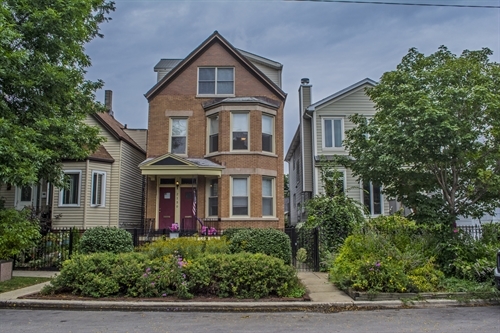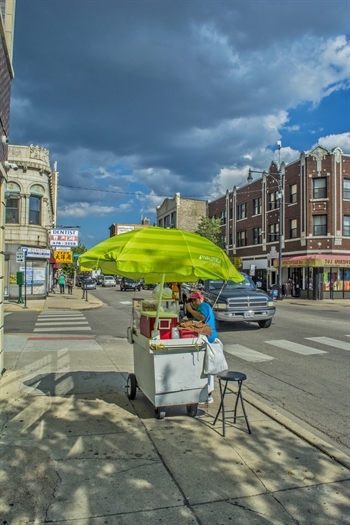A personal reflection on economic displacement

MBA Photography
North Center's Lincoln Avenue
Guess the community: This neighborhood is just miles from Chicago's Loop. It is home to blocks of beautiful historic architecture, quick access to the nation’s 2nd largest business district, and yet has lost 40% of its population from its 1950’s peak. What neighborhood did you picture? If your mind traveled to the South or West Side of Chicago, you’d be wrong. It’s Lincoln Park.
Population loss from peak levels is much the same in Lakeview—30,000; North Center—17,000; and West Town—a shocking 106,000 residents. We think of the neighborhood cluster that includes Bucktown, Wicker Park, Lakeview, Lincoln Park and North Center as booming. However, the blog City Notes instead calls this “unnecessary population loss”. As the maze of construction cranes continues ever skyward, the fundamental character of these neighborhoods continues to evolve. Once home to mostly families, the average household size has plummeted. Even as the number of homes, condos, and apartments has exploded, the number of people living in them continues to fall. Transported from an '80s time machine, Uncle Buck wouldn’t recognize his Wrigleyville block. I’ve seen this shift too—vividly in North Center, where I used to live, and now in Albany Park where I’ve relocated. This is my personal reflection on neighborhood change, and potential solutions to mitigate its worst impacts.
The Reshuffling
Chicago's Northwest side is filling up with former North Center, Lincoln Square, Lakeview and Lincoln Park residents. My wife and I joined this category as we moved to Albany Park. Confronted with spiraling housing costs and the shifting floorboards of a century-old garden apartment in North Center, the time was right to leave. Our creaky building soldiered on only because of the zoning code grandfathered coach house. Immediately next door, a similar vintage cottage was leveled for a multi-million dollar palace built on spec. Our block became bookended by University of Michigan and Iowa-centric sports bars. Gut-rehabbed, multi-family conversions abutted an ever-expanding Coonley Elementary School. In fact, North Center has lost 4,000 housing units in the last 17 years (according to 47th Ward Ald. Pawar).
Community change does not look the same everywhere. North Center’s evolution is not so much an issue of racial displacement, but of income and class stratification. North Center is a far different place than it was at the birth of the new millennium. Back then, the neighborhood was overwhelmingly working class. The sons and daughters of auto mechanics, machinists, first-responders and retail clerks grew up here. Coonley was a school with a dwindling enrollment heading down the path towards closure. Before craft brew pubs, yoga studios, and (perhaps most revealingly) tattoo removal clinics—North Center was the picture of Chicago’s working-class roots. In North Center, one had a safe, walkable community with a broad mix of shops to satisfy needs.
Live from North Center
I saw the change first-hand, volunteering at the 47th Aldermanic office and hearing constituents daily. Mostly, it was mundane complaints about garbage collection or tree branch removal. However, many older residents were terrified of not being to age in place. In a neighborhood with rocketing property values, many on fixed incomes could no longer afford the increasing tax burden. While selling promised a one-time windfall, many just wanted to stay in the house where they had built their lives. Older residents enjoyed the mix of retail, the tree-shaded streets, and visiting friends they’d known for decades. Even if their home’s sale price would fund their retirement, leaving was not a happy prospect.

MBA Photography
A residential block of converted 2 flats in North Center
The recent success of Coonley and Blaine elementary schools came with unintended consequences. Apartment rents have skyrocketed, with many families spending an ever larger percentage of their income to crowd inside the neighborhood enrollment boundary. Young families without children like mine have also been priced out. A hefty $450K is now the entry point, so almost all houses and most condos remain out of reach for the average Chicagoan. Stories abound of homeowners approached with $700,000 cash in hand just for the land.
A third demographic shift is rapidly buffeting North Center and communities like it. The first generation of new families who planted roots in the early 2000's have children entering high school. The investment of time and resources at Coonley does not automatically continue to Lakeview High School. For families whose children do not get into selective enrollment high schools (i.e. Jones, Northside, Payton, Lane Tech, and Whitney Young), a decision must be made. Option 1: Student goes to Lakeview. Option 2: Student goes to a private high school. Option 3: Student goes to a public school in the suburbs, necessitating the family’s move. Too often, families opt to leave the city entirely.
North Center no longer has a well-balanced population across age range or income levels. Crain's explains that, for most of the city’s “history, when a neighborhood became more popular, builders created more housing, turning houses into three-flats, and three-flats into courtyard buildings. In a few really high-demand areas, such as along the lakefront or near downtown, they might even have built highrises. The exact opposite is now happening”. The conversion of multi-unit flats into single family homes has the dual effect of increasing housing costs while decreasing population. North Center’s blend of excellent schools, safety, and transit-access, are effectively closed off below a certain income bracket.
I asked longtime North Center resident and author Roger Wright about this shift. “One of the strangest aspects of this current cycle is people knocking down houses and building nothing but a real big yard where the house used to be. Another thing that’s new in my lifetime is having the knowledge that no matter what we put in our little cottage, for example plumbing repairs, they (the new residents) are still gonna knock the place down when we eventually move.”
Alternative Paths to Re-development?
Even if total population or density remain similar, the neighborhood can feel completely different. Of course, no neighborhood remains static. But at what threshold can we say a neighborhood is destablized by change? On the extreme end of this progression, the 11-story behemoths crowding California and Milwaukee Avenues doubtless increase density but also alter the entire character of an intersection from cozy to crowded. Perhaps this all is a matter of degrees, a subjective classification in the eyes of the beholder?
Per MPC Manager and housing expert Lynnette McRae, “Attracting new residents and investments is an important component of neighborhoods that want to thrive and grow. But we have to be intentional and creative in our thinking around how we ensure that this doesn’t crowd out the existing residents, from policy measures that preserve affordability, to creating opportunities for newer and long-time residents to both feel welcome in their changing neighborhoods.”
So what are the alternatives to such swift change? The Metropolitan Planning Council is deeply committed to exploring creative solutions that expand equity and inclusion for all. MPC’s upcoming Our Equitable Future: A Roadmap for the Chicago Region (to be released May 15) diagrams multiple creative approaches to housing challenges that make sense in a neighborhood context. The organization I work for has long been an advocate for expanding housing choice throughout Northeastern Illinois, and is eager to deepen this important work.
In a New Neighborhood

MBA Photography
A typical street scene in Albany Park
Albany Park has always been a special place for me. I first encountered the city’s spectacular diversity through multi-lingual Lawrence Avenue. As a tutor and later ESL teacher at the Albany Park Community Center, I got to know members of the neighborhood first-hand. One particular classroom included Mexicans, Salvadorans, Koreans, Serbians, Algerians, Uzbek, Somali and Congolese. Nearly every class, a student would bring me a treat from home or invite me to a family gathering. Simply put, Albany Park remains welcoming to newcomers and their descendants. That welcoming attitude has produced a vibrant space in which Christians, Jews, Muslims and Buddhists not only co-exist but engage one another.
A key reason for this varied cultural tapestry is affordability. Even today, this neighborhood offers accessible prices for first-time home buyers as well as renters. Enclaves formed here initially because of affordability with cultural institutions and businesses following suit. Linked by the CTA Brown Line, residents are never far away from key job nodes in the Loop and Lakeview. The neighborhood supports dozens of restaurants and hundreds more businesses, many catering to specific populations. I love 24-hour bakeries offering Conchas and Pan Dulce, Arab grocers packed to the gills with various tea sets, Korean fish markets offering up high-quality, but low-cost sushi. It is a wonderful thing to be greeted in different languages or invited to neighbors’ parties while passing through my alleyway. That is the Albany Park I love.
There is clear irony that change begets more change elsewhere. I am not the first to take advantage of affordability while lamenting the loss of “authenticity”. This may look differently in Albany Park than in North Center, Bucktown or Logan Square—but it is happening. We are the leading edge of the change in Albany Park, a trend I see accelerating by the month. There is no shame in wanting a safe neighborhood with good schools and close access to transit. However, the challenge emerges in how to balance the old and the new to maximize opportunity for all.
For more information on MPC’s housing and equity work, please visit MPC’s website. MPC regularly publishes Data Points which examines the numbers and the policies behind the headlines.